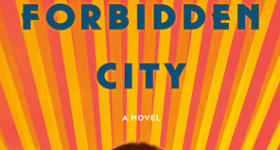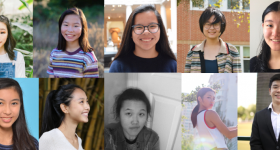Cooking was one of two things. For viet food, a mystery managed and magicked by the adult women in my family; for American food, an easy formula of supermarket shortcuts of pasta sauce from jars and frozen dinners. I grew up in a viet refugee family in Maryland in the ’80s and ’90s. My extended family threw weekly parties, often at my house, the central hub, food served from giant vats and trays. Women’s cackles from the kitchen accompanied the hum of sizzling food. The men lounged, smoking and drinking beer. My mom cooked and lounged and smoked, and I would inherit this sideways approach to gender, this urge to do — be — more than what is allowed, including by way of food.
I was the baby of the family, the first to be born in the United States, the center of attention for all my newly arrived older cousins, many of whom lived with us immediately after arrival before their families found places of their own. I was never made to learn the mysteries of the kitchen. I was spoiled. I was also the bad girl, the wild child who didn’t obey, who was never proper. I quickly learned, with my mother’s encouragement, to opt out of our family’s systems of social control. My mother had opted out by trying to excel at all things, both women’s and men’s; I opted out by refusing to play at all. Why try to follow the rules when you are set up to fail? (Queers by definition are failures.) By the time I was a teenager, I could cook two things and two things only: spaghetti (with sauce from a jar) and steak.
In college, I learned from friends how easy it is to feed yourself with frozen food and eating out. In grad school in California, I discovered Trader Joe’s. I started watching Food Network. Chipper white women like Rachael Ray could make from-scratch meals in 30 minutes! So I bought her cookbook, where I learned that her 30 minutes were not exactly the same as my “30 minutes,” but I was happy to begin expanding my repertoire. I moved in with my then-partner and suddenly we were a household; I wanted to cook for him, to feed us. Apparently, gender is harder to escape than you think.
Then I discovered America’s Test Kitchen. The perfectionist in me was deeply intrigued by its model — testing and perfecting recipes, even testing kitchen tools and appliances to find the best ones. Being the best is the lifeblood of being an Asian American. And so I watched the show obsessively and eventually bought the cookbook. It was much more satisfying than Rachael Ray’s; tested, foolproof recipes I could follow for a wide range of American (and some non-American) cooking, with reliably tasty results. Suddenly I was making whole roasted chicken, chicken pot pie, Cincinnati chili, carbonara, chicken marsala, all from scratch. I was handling meat and learning little tricks and building simple American flavors.
And because the food I cooked became reliably good, and because I had a handful of more-than-decent recipes under my belt, I started cooking for others: hosting dinner parties, gifting food to friends and family. I moved back to Maryland but mailed packages of food back to friends in California. I even flew back to California to cook for a friend during the week of her doctoral exams. Cooking became love, became care.
Food was the center of social life. Potlucks with friends were the second-gen version of the extended-family party — my house, one of the new hubs, my second-gen Asian American friends, the new extended family. I cooked and lounged. (I’ve never smoked, but by now, the late 2000s, most second-gens had quit, as had almost all of their first-gen parents, including mine.) In fact, we all cooked and lounged. Cooking was no longer the definitive gender boundary; gender would find clearer expression in other ways, other social expectations around clothing, leisure, and, later, parenting. (I wouldn’t fit into any of these either.)
I cooked well enough to feed myself and a few friends. I had a handful of go-to dishes. I think most people might stop there: feed yourself functionally, learn one or two dishes well for sharing at potlucks, and go out to eat for the really good stuff. Cooking as feminized labor, what is expected of you as a good wife and mother and socializer, is not a skill in need of high mastery to enable a climb into (upper) middle-class Asian American respectability. Especially when you can just eat out at fine dining. Cooking is not the SATs. Nor is it the piano. And it definitely isn’t the big house, nice car, or luxury vacation.
But I decided to take culinary classes. Because that’s how you really become the best. And because by then I realized that food was not a mystery but a thing that can be mastered, and then enjoyed even more through that mastery — in eating, in sharing, and in performance. Cooking may not be the SATs, but it was still something one could excel at. I may have been able to escape/reject the particulars of Asian American aspirational ascent (with a humanities Ph.D., I am by definition the wrong kind of doctor, and, as an adjunct, a “failed” academic at that), but I did not escape the overall scaffolding of exceptionalism and its telos. Be the best, or be nothing at all.
After half a year of classes (I had to stop early because I had a baby!) and then several years developing particular skills at home, I consider myself semi-trained. Or at least a very skilled home cook. I have worked to expand and refine my palate. I can manage 3-4 dishes at once easily, can cook for 10 comfortably, have decent knife skills, have excellent flame control, can break down a chicken and spatchcock a turkey, can handle most cuts of beef and pork (including heads!), can build and layer flavors, can pan-sear, poach, broil, roast, and pressure cook. I cook almost everything from scratch, using fresh ingredients as much as possible. When needed, I can cook vegetarian, vegan and gluten-free. I make homemade salad dressings and jams.
I stopped cooking.
***
My partner and I fell in love over food. Over long letters detailing our favorite things to eat and cook. Exquisite dinners out trying new restaurants around town. Day-long cooking dates, cooking for each other, with each other, learning from each other. His cooking style and knowledge were so different from mine. Whereas I followed recipes and weighed and measured, he followed flavors, experimenting with new ingredients and developing new dishes. Whereas I knew only standard American dishes, he cooked widely, loving regional dishes of Italy, flavor profiles from South Asia, and of course, the foods from our motherland. We discovered that I had eaten more widely in terms of viet food, growing up embedded in a viet community, but he had learned to cook a couple favorite dishes, making sure he could replicate them to feed himself. In fact, he had taught himself to cook as a teenager, had continued teaching himself through college and beyond. Cooking as experimental, as comfort, as joy. Cooking as romance. We had both learned in our childhoods that food is love, but we had both bucked tradition in terms of how we incorporated this love and its labors into our lives.
***
In May 2017, “You Should’ve Asked,” a comic by French comic artist Emma on gendered divisions of labor, especially the mental management of a household that it calls women’s “mental load,” went viral on social media. None of it was new; as a feminist scholar, I had read about the double-shift and the feminization of labor and women’s emotional labor and invisible labor and all the other terms we’ve developed over decades to describe how our homes and intimate relationships are some of the least equitable or feminist spaces in our lives. But this comic came as a timely reminder. It helped me understand why I had stopped cooking.
My partner and I had just moved in together and gotten married about 7-8 months prior, bringing our children from previous marriages together to form our new blended family. The blending had begun long before with playdates and social activities, a 1-2 year process surprisingly smooth considering one aggressively unsupportive co-parent. But now we were finally all living together, blending space, household chores, caregiving responsibilities, and calendars. And somewhere in there, I completely stopped cooking.
I stopped to rebalance the division of labor in our household and marriage — and for my own mental health.
***
I’ve written about struggling with postpartum depression, on how after having my daughter seven years ago, life felt hard not simply because of biochemistry but also because there were not enough structures in place to support me, to provide the care I needed. In fact there were structures in place to punish me and see me fail. Our narratives of motherhood as martyrdom, as self-sacrifice, our conflation of need and weakness, our ableist ideas about strength and resilience: these are gendered and racialized ideals of what it means to be human, acutely shaping the ways life can feel unlivable for mothers. I’ve written about what mothers need in order for life to feel more livable: the ability to be full people, the permission to have needs, the structures to meet those needs. My work in mental health since has been about locating suffering in structures of violence and wellness in structures of care.
In other words: what do we need to build so that life is no longer differentially unlivable, so that life can feel livable for everyone, of all capacities?
Since the publication of the first edition of my arts and humanities project Open in Emergency: A Special Issue on Asian American Mental Health in late 2016, I’ve traveled around the country asking folks what they think mental health is. What does mental health mean to you? What does wellness look like? The answers are so rich, so aspirational, so unapologetic for the complexity of human suffering and human dignity. The longing for lives that feel livable, for something different from what they — we — have been given, is both heartbreaking and hope-making.
They almost never say that health is the ability to work.
I and they have been the least convinced by that particular definition of mental health. The ability to “function,” to “be productive.” Our conversations always end up critically examining those words: what does it mean to function? By whose standards? What does it mean to be productive? To whom, and for whom? Who benefits when we are “functional” and “productive?” And what are the costs to ourselves and to others?
I stopped cooking because it was beyond my capacity. Because it was work that became too much in light of everything else I had to do and be and survive. Because I am allowed to need, I am allowed to have structures of care. Because I want to be, and should be, more than a person who does or does not function.
***
I’ve begun exploring bread-making, inspired by friend and fellow mental health writer Pooja Makhijani, who posts amazing pictures of her baked creations and has also written about her own food journey. Again, I am obsessively trying to learn this new skill, tweaking recipes to learn how yeast and proofing work, making the same bread over and over to understand the variables and how to perfect it, finding joy again in skill-building, in producing something delicious, in sharing it with others. But breads are “extras,” not needed to feed our family in our daily life and so not a responsibility. A hobby, something fun. Not something else I have to take care of, another task that I don’t have enough spoons for. Duty is a task-mistress I am still deeply suspicious of as a queer Asian American woman, a Vietnamese American daughter. I accept duty sparingly and only after wary examination. And so I make breads only when I feel like it. They bring joy, to me, my partner, my daughter, my siblings, my parents, my neighbors. Joy I can make and share, when I can.
***
I still don’t know how to cook viet food. I’ve learned one dish and have perfected it to my taste: phở, both beef (oxtail!) and chicken. But my culinary classes were American, drawing on French technique. I’ve tried taking a class here and there on viet food, and I’ve asked my mother and stepmother and a cousin in Vietnam to teach me over the last few years, but I’ve found the process opaque, too dish-focused, hard to access as viet flavor-building and technique. I understand how to eat viet food but not how to cook it. I have trouble reproducing dishes, and I cannot improvise.
I have Andrea Nguyen’s cookbook Into the Vietnamese Kitchen: Treasured Foodways, Modern Flavors collecting dust somewhere. Maybe I’ll take it out and finally learn how to make bún bò huế or canh chua or chả giò or cá kho … for fun. And to learn new techniques, to perfect a dish, to share with others. On the weekend. When I have the spoons. After my partner has already fed the family. More joy to make and share, when I can.
***
I plan to teach my daughter how to cook someday. And how to not cook, too.










Comments